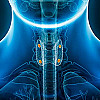Trigger finger

Trigger finger is a painful condition in which a finger catches or becomes locked when you try to straighten or bend it. Although the name may conjure up visions of sharpshooters and hunters, it comes from the trigger-like snap that occurs when the finger suddenly releases. This condition, officially known as stenosing tenosynovitis, usually affects the thumb or ring finger, though it can affect any finger.
Trigger finger begins in the tendons that bend the fingers and the connective tissue pulleys that hold those tendons close to the finger bones. The tendon normally glides smoothly through the sheath that surrounds it. If the tendon develops a knot, or if the sheath covering the tendon swells and narrows, the tendon can't move as easily. The tendon can catch and get stuck, causing pain, popping, or a catching feeling in the finger or thumb. The more often the tendon catches, the greater the swelling and irritation, and the greater the swelling and irritation, the more the tendon catches.
What are the symptoms?
The first symptoms of trigger finger tend to be pain and a slight thickening at the base of the affected finger or thumb. The characteristic snapping sensation can start suddenly, or develop gradually. Pain may felt toward the end of the finger or thumb or in the palm. You may find that the finger or thumb is locked toward the palm when you wake up and gradually releases over the course of the day.
It may seem like the problem is related to the middle knuckle of the finger or the top knuckle of the thumb. But it's actually arising from the base of the affected digit. Sometimes you can release a locked digit by massaging it at its base.
What causes trigger finger?
|
Trigger finger is an often painful condition that affects a finger or thumb. Symptoms include a sensation of "catching" when trying to bend or straighten the finger. The name comes from the trigger-like snap that occurs when the finger suddenly releases. A bump (nodule) may also form. |
It's not clear what causes trigger finger. Aging may play a role, since it tends to happen to people over age 40. People with rheumatoid arthritis, gout, or diabetes are more likely to develop trigger finger than those without these conditions. It is also more common in people who, for work or play, use their fingers or thumbs in repetitive movements, such as musicians or industrial workers.
How is it diagnosed?
Your description of the problem and an exam by your health care provider are usually all that's needed to diagnose trigger finger. X-rays and other tests usually aren't needed. Your provider will check for pain and swelling at the base of the finger or thumb as you open and close your hand and perform other hand movements. (Another condition, Dupuytren's contracture, can also cause difficulty straightening a finger, but it's usually painless.)
How is trigger finger treated?
The first step in treatment is to stop doing anything that aggravates the condition. That, of course, is easier said than done, especially if you rely on your hands for work. The second step is to immobilize the affected finger or thumb, either by taping it to a neighboring finger or by using a splint. Splinting at night can be especially helpful in preventing the thumb or finger from becoming locked.
If the digit is painful, applying an ice pack several times a day can help. Taking an over-the-counter nonsteroidal anti-inflammatory drug like ibuprofen (Motrin, generic) or naproxen (Aleve, generic) can help ease pain and inflammation. Like all drugs, these can have unwanted side effects. So talk with your doctor if you will be taking a nonsteroidal anti-inflammatory drug long term.
If severe locking or other symptoms still occur after four to six weeks of immobilization, your health care provider may recommend a steroid injection into the base of the affected finger or thumb. If symptoms still haven't improved after six weeks, a second injection may help.
When locking and pain persist, surgery may be an option. Surgery for trigger finger opens the tunnel through which the tendon passes. This lets it glide more easily through the sheath. Surgery usually restores finger movement immediately, and you can begin gentle range-of-motion exercises within a few days. Postsurgical swelling and discomfort may last for a month or more.
Disclaimer:
As a service to our readers, Harvard Health Publishing provides access to our library of archived content. Please note the date of last review or update on all articles.
No content on this site, regardless of date, should ever be used as a substitute for direct medical advice from your doctor or other qualified clinician.
















